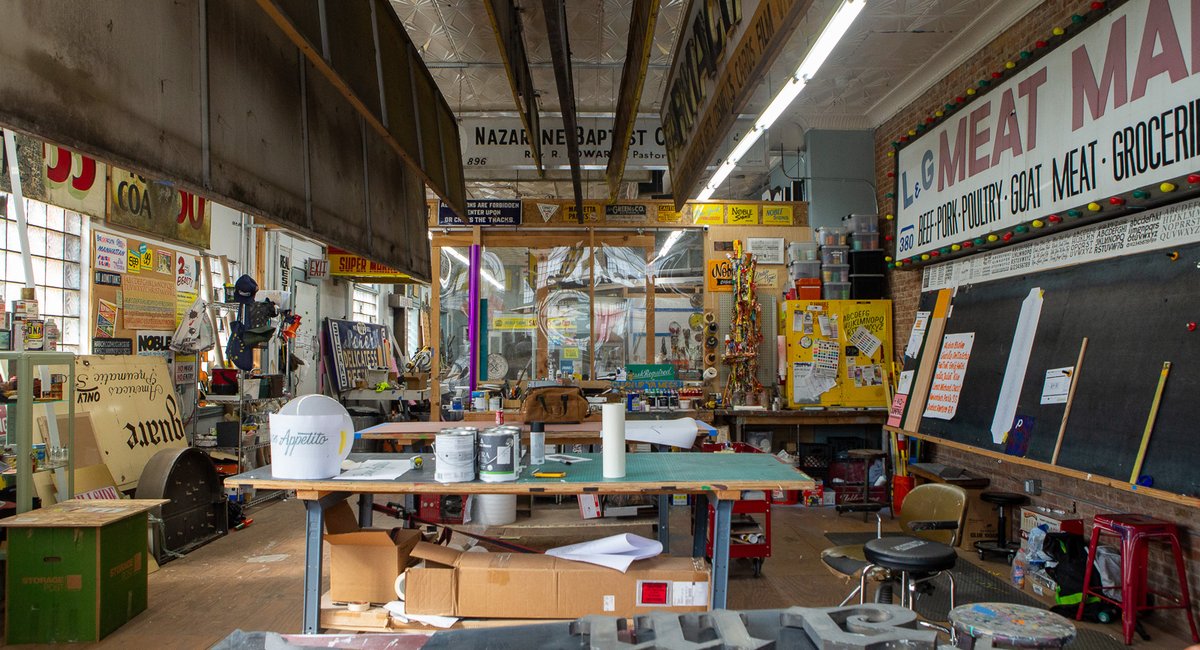Have you ever noticed a great, old sign in your neighborhood — perhaps above a bodega, or laundromat, or other local business? It’s possible you only noticed it after it was gone — after the business closed and became a Popeye’s or maybe a Cricket Wireless, and the vibe of the neighborhood shifted just so.
David Barnett hates this vibe shift. So much so, that he’s devoted his life to halting it.
Barnett is the force behind Noble Signs, a signmaking studio he co-founded in 2013 out of “an appreciation for the vanishing classic signage of New York City.” He’s also the founder of the New York Sign Museum on Atlantic Avenue in Brooklyn. The museum was established in 2019, with a mission of preserving the great old signs that come down every year and would otherwise go to scrapyards.
“I’m lucky I’m alive,” Barnett said during a tour of the museum, which doubles as his fabrication shop. “I’ve craned my neck around to look at a sign and almost crashed my car more times than I can remember.”
He’s rescued classic signs from Essex Card Shop, which replaced its sign after a fire in 2022, and from Queen, the red-sauce Italian restaurant that reigned in Brooklyn Heights for 62 years before shuttering in 2020. He has dozens of signs from bodegas, pharmacies, auto repairs and Jewish delis. Some are small. Others are taller than him, or stick far out the back of his box truck.
“Signage that was handmade with so much personality really defined the aesthetic experience of living in a New York City neighborhood, maybe even more than the architecture,” Barnett said. “The tide we’re trying to push against was to find that character, the thing that makes interacting with your environment fun — that personality and playfulness that is just not the norm anymore.”
The museum’s and studio’s parallel missions of preservation and creation feed into each other, Barnett said: every old sign they rescue teaches them something about how to make their own.
“You can design something that looks classic, but if you don’t make it the classic way, it might have an ersatz feeling,” Barnett said.
A sign for Queen, the red-sauce Italian restaurant in Brooklyn Heights that shut down in 2020 after 62 years.
Ryan Kailath / Gothamist
Barnett keeps a mental map of great old signs to check in on regularly. When he learns that a well-signed business is nearing the end, he makes his approach.
“The first thing I usually say is: ‘Hey, I love your old sign. Do you have any plans for it?’” Barnett said. “Often people go ‘Oh, that old thing?’”
Barnett pulls out his card, explains that he represents a real business, that he has insurance and will come de-install the sign for free. He estimates his success rate is less than 50%.
“The irony is that often people would rather pay literally thousands of dollars to have someone come throw the sign out,” Barnett said. “I don’t know why.”
He speculates that one reason is very simple, and very New York: as soon as you tell someone you want something, they wonder if they can get a better offer somewhere else.
Unfortunately, Barnett said, they usually can’t.
“A lot of these signs, if they were 50% smaller, they’d be worth a lot of money,” Barnett said. “But who’s going to take a 30-foot sign?”
Signs in the New York Sign Museum range in size and style.
Ryan Kailath / Gothamist
Signs of the times
Barnett said that before the Instagram age, signmaking was even more of a dead art form — popular brush lettering and neon appreciation accounts have helped to revive interest and spread knowledge.
Before that, he recalls mining libraries and eBay for old books on the craft, learning about 20th century signage and the mid-century giants of the industry, like Silverescent Neon, which made signs across Coney Island and Brooklyn, and Artkraft Strauss, which designed iconic signs in Times Square.
“Before neon, there were bulbs, and before bulbs, the original lighted marquees in Times Square were made by cutting letters out of tin and filling them with candles,” Barnett said.
One of his favorites is the Canal Rubber Supply Co. sign in lower Manhattan. Barnett was honored to work with the business on a restoration of its classic sign last year.
The owner of J & R Television and Air Conditioning said knowing his sign would be preserved in the New York Sign Museum made it just a little bit easier to retire after decades in the business.
Ryan Kailath / Gothamist
Last month, the museum’s crew was in Park Slope, de-installing a sign from J & R Television and Air Conditioning.
Owner Ralph DiCerbo had worked behind the counter since he was 12 years old — his father opened the business in 1953.
“I’m happy to be able to retire, but it’s very bittersweet,” DiCerbo said. “I grew up here, I know all the customers. We have a lot of old people who rely on us to change their batteries and tell them what vacuum bag they need, the small stuff.”
DiCerbo said knowing his sign would go to a museum helped to take the edge off.
Some film production companies were interested in taking it — the sign has been featured in movies, television, graphic novels and even the video game “Grand Theft Auto,” Di Cerbo said — but the family voted and decided it should go with Barnett instead.
“If we want to see it, I could bring my grandchildren one day, if I ever have any,” Barnett said. “And say ‘Hey, that’s where your great-grandfather started.’”
